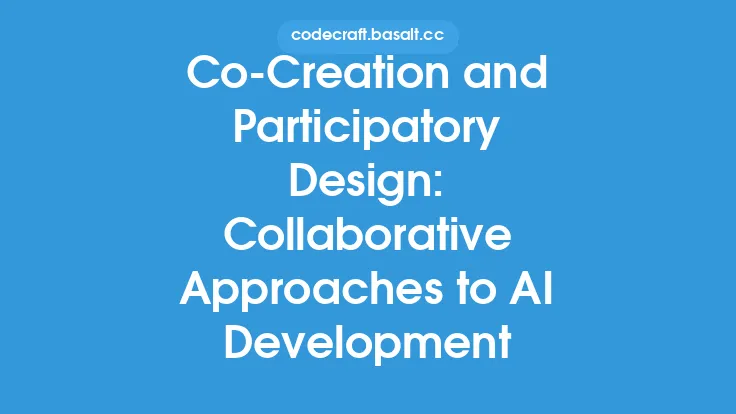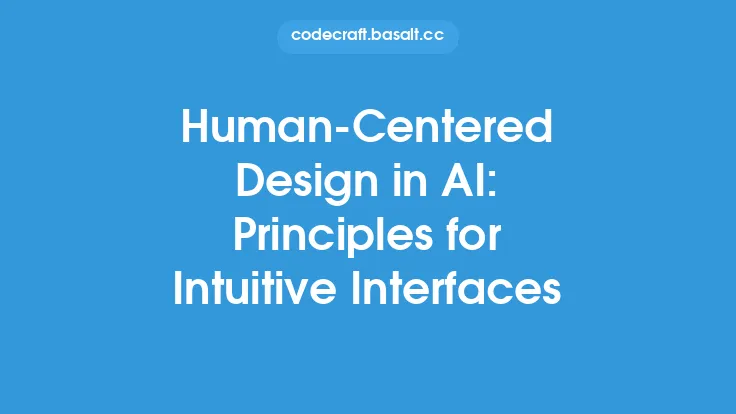As artificial intelligence (AI) becomes increasingly integrated into various aspects of our lives, the importance of ethical considerations in AI interaction has grown significantly. One of the key challenges in designing AI systems is striking a balance between transparency and usability. On one hand, transparency is essential for building trust and ensuring that users understand how the system works and makes decisions. On the other hand, usability is critical for ensuring that the system is intuitive and easy to use, which can sometimes require hiding complex details from the user. In this article, we will delve into the ethics of AI interaction, exploring the tension between transparency and usability, and discussing strategies for balancing these competing demands.
Introduction to Transparency in AI
Transparency in AI refers to the ability of a system to provide clear and understandable information about its decision-making processes, data sources, and potential biases. Transparency is essential for building trust in AI systems, as it allows users to understand how the system works and makes decisions. There are several types of transparency, including model transparency, data transparency, and procedural transparency. Model transparency refers to the ability to understand how the AI model works, including the algorithms and techniques used to make decisions. Data transparency refers to the ability to access and understand the data used to train and test the AI model. Procedural transparency refers to the ability to understand the processes and procedures used to develop and deploy the AI system.
The Importance of Usability in AI
Usability is critical for ensuring that AI systems are intuitive and easy to use. A usable AI system is one that is designed to meet the needs and goals of its users, and is easy to learn and use. Usability is essential for ensuring that users can effectively interact with the AI system, and that the system provides a positive user experience. There are several principles of usability, including simplicity, consistency, and feedback. Simplicity refers to the ability to present complex information in a clear and concise manner. Consistency refers to the ability to use consistent design elements and terminology throughout the system. Feedback refers to the ability to provide users with clear and timely feedback about their interactions with the system.
Balancing Transparency and Usability
Balancing transparency and usability is a complex challenge in AI design. On one hand, providing too much transparency can overwhelm users with complex information, making the system difficult to use. On the other hand, providing too little transparency can erode trust in the system, as users may not understand how it works or makes decisions. To balance transparency and usability, designers can use a variety of strategies, including progressive disclosure, aggregation, and visualization. Progressive disclosure refers to the ability to provide users with increasing levels of detail and complexity as they interact with the system. Aggregation refers to the ability to combine complex information into simple and concise summaries. Visualization refers to the ability to use visual representations to communicate complex information in a clear and intuitive manner.
Technical Approaches to Transparency and Usability
There are several technical approaches to transparency and usability in AI, including model interpretability, explainability, and attention mechanisms. Model interpretability refers to the ability to understand how the AI model works, including the algorithms and techniques used to make decisions. Explainability refers to the ability to provide clear and concise explanations of the AI model's decisions and outputs. Attention mechanisms refer to the ability to focus the user's attention on specific parts of the system or output, in order to provide more detailed information and context. Other technical approaches include the use of natural language processing (NLP) and computer vision to provide more intuitive and user-friendly interfaces.
Human-Centered Design for Transparency and Usability
Human-centered design is a critical approach to balancing transparency and usability in AI. Human-centered design involves designing systems that are centered on the needs and goals of the user, and that provide a positive user experience. To design AI systems that are transparent and usable, designers must engage in user research, usability testing, and iteration. User research involves understanding the needs and goals of the user, as well as the context in which the system will be used. Usability testing involves testing the system with real users, in order to identify areas for improvement and optimize the design. Iteration involves refining the design based on user feedback and testing results, in order to create a system that is both transparent and usable.
Future Directions for Transparency and Usability in AI
The future of transparency and usability in AI is likely to involve the development of more advanced technical approaches, as well as a greater emphasis on human-centered design. As AI systems become increasingly complex and autonomous, the need for transparency and usability will only grow. To address this need, designers and developers will need to prioritize transparency and usability in their design decisions, and to develop new technical approaches that can provide clear and concise information to users. Additionally, there will be a growing need for standards and regulations that can ensure transparency and usability in AI systems, and that can protect users from potential risks and biases. By prioritizing transparency and usability, we can create AI systems that are both effective and trustworthy, and that provide a positive user experience.





